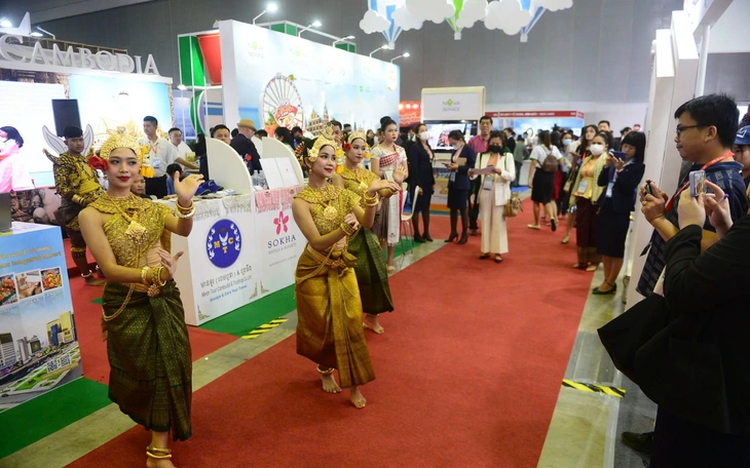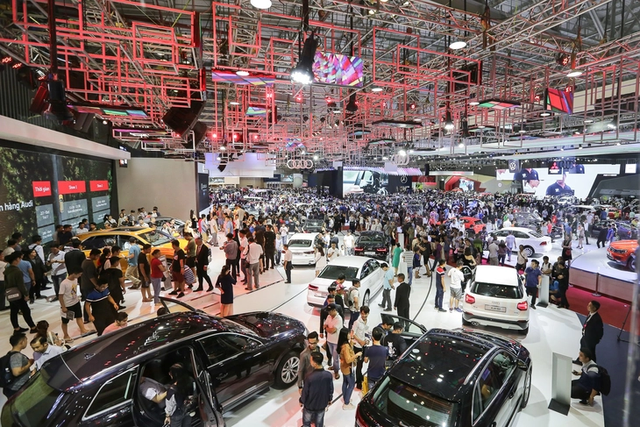
An international tourism event held at the Saigon Exhibition and Convention Center in Ho Chi Minh City. Photo: Quang Dinh / Tuoi Tre
Ho Chi Minh City, Vietnam’s economic powerhouse and largest trade gateway, is facing growing demand for trade promotion and MICE (meetings, incentives, conferences, and exhibitions) activities.
However, the lack of a large-scale, professional exhibition center has become a major bottleneck.
This shortage is highlighted by frequent gridlock around the Saigon Exhibition and Convention Center (SECC), especially when multiple events are held simultaneously.
Businesses have warned that this shortfall risks redirecting events to other regions or even overseas, potentially costing the city key investment and commercial opportunities.
Despite hosting over 400 exhibitions annually, which rises 3.68 percent annually, the city lacks centralized, well-developed venues with an appropriate scale, according to the municipal Department of Industry and Trade.
By contrast, the Vietnam Exhibition Center project in Hanoi, covering 304,000 m² of indoor space, ranks among the world’s top 10 exhibition complexes and sets a clear benchmark for exhibition infrastructure nationwide.
The key lessons lie in the implementation speed, the synchronization of auxiliary facilities, and the effective mobilization of private resources.
In the south, SECC, measuring 40,000 m² in indoor exhibition space and couple with 15,000–20,000 m² outdoors, is still insufficient for hosting very large international events.
To meet the need, Ho Chi Minh City has envisioned the 'Ho Chi Minh City Expo' strategy and planned two exhibition and fair center locations in Thu Thiem and former District 12.
This is a positive sign, but so far it has mostly remained a plan.
Success hinges on choosing locations that maximize logistics, tourism, and trade advantages, alongside flexible investment and operational models to attract global audiences and exhibitors.
A world-class exhibition center must be reachable within 30–45 minutes via expressways, ring roads, metro, or waterways.
It should be on a minimum 50- to 70-hectare contiguous site capable of expanding to 150,000–200,000 m² of exhibition space, with 8,000–10,000 parking spots, hotels, conference venues, and logistics support.
Ideally, it would link with industrial zones, ports, airports, and urban centers to transform exhibitions into trade deals, factory tours, or business scouting excursions.
3 potential locations
Thu Thiem – Thanh My Loi in Thu Duc area: Situated in the city’s future financial and administrative core, this symbolic location could host a high-end MICE hub linked to waterways and key roads, reinforcing the area as a 'MICE–finance–innovation' gateway.
Hiep Phuoc in former Nha Be District: Located adjacent to vast industrial land and near deep-water ports along the Soai Rap River, Hiep Phuoc is well-positioned to connect with the Mekong Delta and Cambodia via waterways.
Once the Ben Luc–Long Thanh Expressway and Beltway No. 3 are completed, the site is ideal for a large-scale expo center dedicated to industrial, logistics, and maritime themes, helping ease pressure on the city center while serving international visitors via Long Thanh International Airport in the future.
Tay Bac gateway in former Cu Chi District: Though farther from the downtown area, the location boasts extensive land availability.
It is well-suited for hosting exhibitions focused on agriculture, machinery, and technical equipment, combining exhibitions with cargo transportation through Moc Bai Border Gate.
Urgent need for decisive policies, rapid implementation mechanisms
In the short term, the city can leverage existing satellite venues to ease congestion.
WTC Expo - Binh Duong New City has been operating with 12,000-14,000 m² of indoor space and 8,000-10,000 m² of outdoor space. It can immediately host exhibitions while creating a convenient corridor for the movement of guests and goods via Beltway No. 3.
At the Cai Mep–Thi Vai port complex, one of the few deep-water ports in the area, establishing an expo center integrated with the port would strongly support the region’s supporting industries and international trade.

An international exhibition event takes place at the Saigon Exhibition and Convention Center in Ho Chi Minh City. Photo: B.V. / Tuoi Tre
International practice shows that flagship exhibition projects succeed with mixed investment structures: land and core infrastructure led by the state; construction, operations, and marketing led by the private sector.
In Ho Chi Minh City, the business community has proposed tax incentives and credit support to encourage private sector participation and accelerate implementation.
It is necessary to establish a mechanism for selecting investors through competitive bidding, with commitments on progress, along with operational indicators on floor utilization rates, the number of international events, and MICE tourism revenue.
Hanoi exemplifies the speed and effectiveness yielded by proper preparation and mobilized resources.
Ho Chi Minh City’s demand is clear, data is compelling, and legal frameworks are opening. What remain are bold decision-making and disciplined, rapid execution to build a world-class expo complex worthy of the city’s leading national and international role.
In the short term, the city should simultaneously initiate investment procedures for a 'flagship' center in Thu Thiem-Thanh My Loi, serving as a symbolic landmark, high-level conferences, and technology-service exhibitions, and a specialized center in Hiep Phuoc, focusing on industry and logistics.
Alongside this, a program to improve access roads, parking, and accommodation services should be implemented.
Looking ahead to 2030, when Beltway No. 3 and key expressway segments are completed, Ho Chi Minh City will be capable of hosting a series of large-scaleregional events, creating a MICE ecosystem that stimulates orders, tourism, and investment throughout the region.
* This article was originally written in Vietnamese by Nguyen Tuan Anh, M.A., and rewritten in English by Tuoi Tre News.


Max: 1500 characters
There are no comments yet. Be the first to comment.